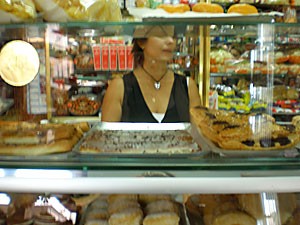I began to realize that Spain was completely different than Tucson when I had the most human of urges: hunger. One of the most noticeable differences between Spanish and American customs is the type of food people eat and when they eat it.
In Spain, everyone eats their meals at home, and they get drinks or tapas (appetizers) in cafǸs. If you order an alcoholic beverage in a restaurant, you can choose from a menu of tapas they serve with the drink free of charge.
People are always eating and nursing their drinks slowly, which is dissimilar to the tragic American custom of binge drinking on an empty stomach.
For breakfast the Spanish typically drink coffee, tea or chocolate milk along with some yogurt or toast with jelly. The toast is an oval-shaped cracker, more like a very stiff, oblong bagel.
Lunch is the largest meal of the day and is served around 2:30 p.m. Classes and work are finished by 2 p.m. so people can go home for lunch. After eating, almost everyone takes a nap. As I learned quickly, a nap is necessary to function because everyone stays up very late; dinner isn’t until 9 p.m. or later.
On my first day here I had lunch with my host mother, Lola, and she made a lot of food that I had never seen mixed together before. The main course was a mixture of egg, spinach and bits of chopped onion, prepared and served similar to scrambled eggs. I came to the realization that I’m allergic to onions after this meal because my tongue began to feel prickly and my throat itched as if bugs had crawled inside of me and decided to eat my esophagus.
The best three things about flying to Spain:
Free pillow, blanket and headphones
Single-serving friends
The duty-free shop onboard where you can buy seven bars of Toblerone for $10
The worst three things about flying to Spain:
Dizzying sleepiness
Seats that are like upright dentist chairs
People who have bad breath and insist on yawning next to you
Spanish song taking over my iPod:
Ojos de Brujo’s “”Techari””
Lola also made a thick potato pancake: slices of potatoes cooked inside a semi-fried tortilla. An unsullied salad comprised of lettuce, cucumbers, tomatoes and olives was prepared from fresh produce bought at the market nearby.
Luckily for me, my host mother accommodates my distaste for meat, being that I am a vegetarian.
There is always a fresh baguette to be found on my host family’s dinner table, which also rings true with other food in the house. I find it surprising that such a plethora of fresh food items is constantly flowing from the cupboards without ever seeing Lola going to the market. It seems impossible that someone could always have so much food to prepare that constantly tastes like perfection.
For dinner, Lola prepared white Spanish rice, which is thick and lightly seasoned. Lola told me that she doesn’t understand why Mexican food is so spicy. The rice Tucsonans enjoy at Nico’s would seem very spicy to her because the Spanish don’t use as many spices as Hispanics generally do in their cooking.
Along with the rice there were “”sausages”” (hot dogs) made of turkey. Lola also prepared fish because, when I told her I was a vegetarian, she assumed that I would eat fish.
I politely tasted it and told her that I came to hate fish as a child because my stepmother would trick me by giving me fish and telling me that it was chicken. Ever since those experiences I have associated fish with deception.
On the second day of orientation, students had already started to come to class hungover. Collectively, we are helping to keep the American binge-drinking stereotype alive, one poor example after another.
Many students who study abroad are not accustomed to the lax attitude towards alcohol, which is served all day, everyday. The legal drinking age here is 18, and it is rare for anyone to ask for identification.
Back to eating. I’ve also had a good experience noshing at Almendre de ǁlcala. The store is part bakery, toy store and candy shop. No one can walk past it without looking into the windows at the various colors of bright sweets, pastries and toys. Almendre de ǁlcala closes everyday from 2-5:30 p.m. for siesta, and people are always waiting outside when they return to partake in the sweet goodness.
My final note about food entails a strange discovery I made while getting bread from the cupboard for a late-night snack. The bread was hanging in a knit bag in the closet where the water heater is.
In the corner of the closet laid an item that I hadn’t noticed before; it looked like the leg and hoof of a cow-like animal. Thankfully, the leg was in a bag and only about 5 inches of the leg and hoof were showing. I stood in shock, staring at the hoof, and lost my appetite for the bread I had wanted so much.
At lunch the next day I asked Lola, in Spanish, “”Why do you have a cow’s hoof in your cupboard?”” She started to laugh and said it wasn’t from a cow, it was from a pig.
Apparently, people use pig hooves here to make soup richer and taste better. The hoof is cut off the leg and put in the soup to soak, and when the soup is finished, the hoof is then thrown away.
The food in Spain may not sound appealing but it is actually very delicious when you try it. Every day I get the opportunity to taste new foods, and I love every minute of it. I’ll most likely return to America fat, but at least the food I’m eating here is healthier than my typical university diet.









